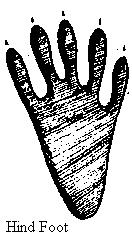Who left these prints?
A muddy shoreline or a fresh snowfall along the river is all you need to become a wildlife tracker. The next time you’re near a stream or river, see how many different animal tracks you can spot. To help you identify some of the more common animals found in the James River watershed, here’s a simple toe counting guide:
The 4 and 5 rule: Four toes on the front feet and five toes on the back feet means you’re tracking a rodent. It could be a mouse, a squirrel, woodchuck, or muskrat.
The 5 and 5 rule: Five toes on the front and five toes on the back feet could be a raccoon (the paw print above), a skunk, a beaver, an opossum or a member of the weasel family, such as a mink. Or, if it’s really big, a black bear. But don’t confuse a big dog paw print with a bear!
The 4 and 4 rule: Four toes on the front and four toes on the back feet could be a dog, a fox, or a coyote. The tracks could also be made by a member of the cat family, like a bobcat or a neighborhood cat. The four-toed tracks may appear similar, but look for the presence or absence of claw marks with the paw print. Feline paw prints do not have claw prints because members of the cat family have retractable claws that are not used for walking. Canine paw prints have claw prints, as will most other animal prints you’ll find.
Take a walk by the water and see who -- or what -- has been there before you!


No comments:
Post a Comment